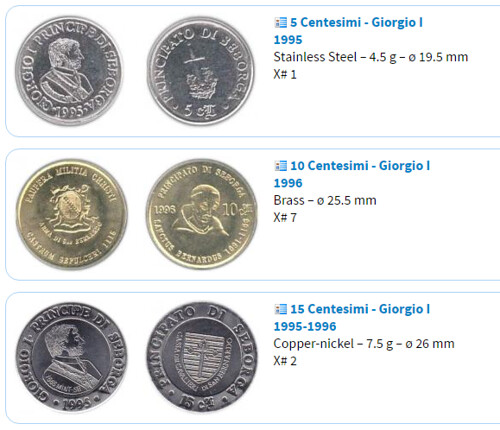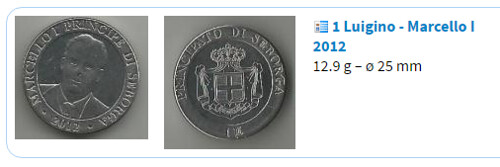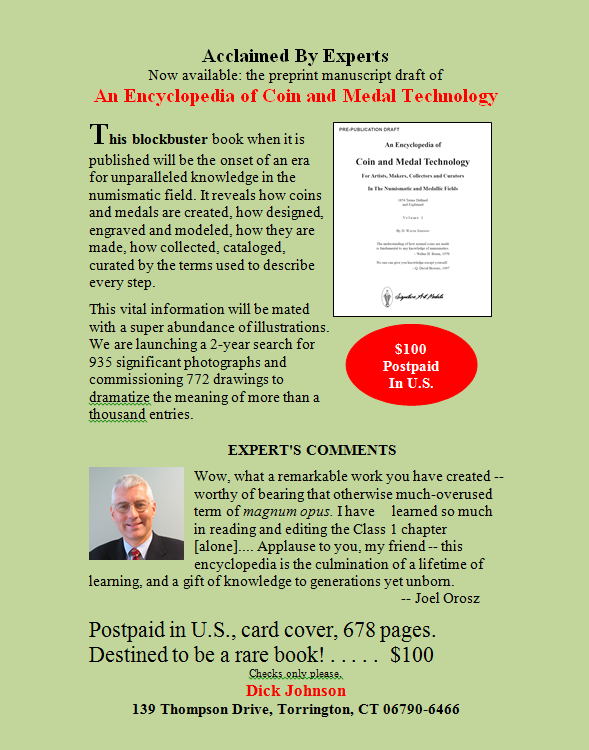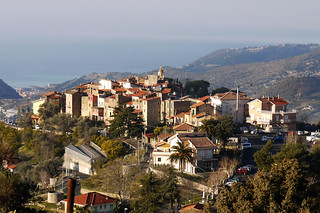
PREV ARTICLE
NEXT ARTICLE
FULL ISSUE
PREV FULL ISSUE
THE COINS OF SEBORGA
The Italian principality of Seborga was in the news this week. The town has issued its own coins in the past, although no mention was
made of the current situation. here are excerpts from the July 5, 2016 Wall Street Journal and a 2012 World Coin News piece
by Richard Giedroyc. -Editor
The 330 residents of Seborga, a picturesque, 1,000-year-old village overlooking the Ligurian Sea near the French border made an appeal for independence long before the U.K. ever had the idea, only to be turned down by every possible legal authority. That was before this spring, when Nicolas Mutte, a shadowy, possibly French figure whose occupation is unknown and who would only answer questions in writing, posted a video online proclaiming himself “His Serene Highness Nicolas I,” Seborga’s new ruler. “A new chapter in Seborga’s history starts today,” Mr. Mutte declared, in French. Top of his wish list was splitting from Italy. His proclamation came as news to Marcello I, more commonly known as Marcello Menegatto, a 38-year-old former professional speedboat racer who was selected to rule Seborga in 2010. “Seborga is a free and sovereign principality that has elected me as its prince,” said Prince Marcello in an interview. “Mr. Mutte has no rights over Seborga.” Never mind that Italy’s constitutional court and the European Court of Human Rights both dismissed Seborga’s petition for independence, or that the hamlet has no legal monarch at all—in reality, a mayor runs the town, applying Italian laws. The struggle for the throne has stoked serious passions. “Due to its history, Italy is very sensitive to the idea of micronations and local independence,” says Graziano Graziani, an Italian writer who studies micronations. In the 1960s, some of Seborga’s residents began to claim Italy had annexed the town “illegitimately and unilaterally,” according to the principality’s official website. A local flower farmer named Giorgio Carbone started a liberation campaign. Seborga residents embraced his claim and elected him prince in a locally organized vote in 1963. Under Giorgio I, the principality adopted a constitution and a national anthem, and appointed ministers and representatives abroad, including to the U.S. It resurrected the white and azure flags of the ancient principality. When Prince Giorgio died in 2009, he was succeeded by Prince Marcello, a local real-estate entrepreneur, elected to a seven-year term. Over time, the urge to secede waned, as the royal government and its traditions mainly served as a tourist attraction. To read the complete article, see:
Here's some background on Seborgan coinage fromWorld Coin News. -Editor
Seborga is a principality landlocked inside Italy that unlike San Marino and Vatican City, is often overlooked by coin collectors. According to the January issue of Hemispheres magazine, “You can also try to dig up a few rare luigini, the local currency, to pay for your expresso. (Stores in town accept luigini alongside the euro, but because 1 luigino equals 4.285 euros, making change can be a complicated procedure.)” Collecting coins of Seborga may be a challenge since not many were made, but the greater challenge may be trying to figure out what coins have been made in recent history. The Seborga Mint actually dates to 1666 when gold and silver luigini denominated coins were struck by Prince-Abbot Edward. In more recent history, coins were issued between 1995 and perhaps 1996, with some unofficial issues struck in 1994. It appears there are 29 coin types issued in both base and precious metal issued in modern history. The base metal issues really were meant to circulate, while the precious metal content coins were meant strictly for collector consumption. Seborga’s 20th century coins were issued in denominations of 5, 15 and 50 centesimi (expressed as a 1/2 luigino), as well as 1 and 7.5 luigino. No bank notes have been issued. It is understood no further coins have been produced since 1996. The Italian government has taken a dim view of the fact Seborga chose to strike distinctly modern coinage designs on coins meant to be used as money, rather than making official restrikes of its 17th century issues to be sold as souvenirs. The Italian government has put pressure on the local Seborga prince to abandon the luigini in favor of the euro, but at the time this article was being written it was understood the luigini is still treated as a legal tender currency as was explained in Hemispheres magazine. To read the complete article, see:
The Numista site has a page with images of eleven Seborgan coins. -Editor


To read the complete article, see:

Wayne Homren, Editor The Numismatic Bibliomania Society is a non-profit organization promoting numismatic literature. See our web site at coinbooks.org. To submit items for publication in The E-Sylum, write to the Editor at this address: whomren@gmail.com To subscribe go to: https://my.binhost.com/lists/listinfo/esylum All Rights Reserved. NBS Home Page Contact the NBS webmaster 
|
